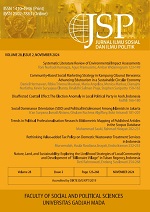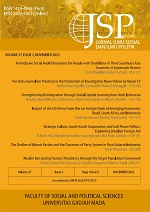Public Distrust and Environmental Citizenship: Primary Impetuses of Radical Protest in Bima District, 2011-2012
Rahmad Hidayat(1*)
(1) Department of Administrative Science of STISIP Mbojo Bima
(*) Corresponding Author
Abstract
This article aims to show how the social movement was conducted in the framework of claiming a number of aspects of citizenship, especially environmental rights and political participation, to the local government. The refusal of FRAT Bima over the extractive policy of the Government of Bima District during 2011-2012 becomes a reflective context of the type of social movement with such a framework. This social protest should be explored further because it used acts of vandalism on some public facilities as the chosen way to fight against the environmental and political injustices. Through a case study, the author aims to explore the sequence of repertoires which were applied sequentially by FRAT Bima’s social protest as well as to examine its linkage with environmental citizenship and public distrust. Despite being closely related to citizens' awareness about environmental citizenship, the occurrence of this anarchist movement was also triggered by the low level of "formal legitimacy" of the local government as a seed of public distrust towards the intentions of environmental governance policy that was about to be applied to make the agricultural land owned by villagers as the site of a certain project of mineral extraction. The lack of the government’s formal legitimacy, which was supported by the growing awareness of environmental citizenship, has led the sequential application of conventional and non-conventional strategies in the demands articulation of FRAT Bima. This sequence of repertoires was held due to the low-level of government's responsiveness in accommodating the public claims about the cancellation of an undemocratic environmental policy.
Keywords
Full Text:
PDFReferences
Andrews, K. T. & Edwards, B. (2004). Advocacy organizations in the U.S. political process. Annual Review of Sociology, 30, 479-506.
Ascher, W. & Mirovitskaya, N. (2016). Development strategies and inter-group violence: Insights on conflict-sensitive development. New York: Palgrave Macmillan.
Banpasirichote, C. (2004). Civil society discourse and the future of the radical environmental movement in thailand. In Guan, L. H. (ed.), Civil Society in Southeast Asia (pp. 234-264). Singapore: ISEAS Publications.
Bupati Bima. (2010). Surat keputusan Bupati Bima No. 188.45/357/004/2010. Bima: Bupati Bima
Creswell, J. W. (2007). Qualitative inquiry and research design: Choosing among five approaches. (2nd ed). Thousand Oaks: Sage Publications.
Dalton, R. J. (1988). Citizen politics in western democracies: Public opinion and political parties in the united states, great britain, west germany, and france. Chatham: Chatham House.
Della Porta, D. & Diani, M. (2006). Social movements: An introduction. Oxford: Blackwell.
Drury, J., Reicher, S., & Stott, C. (2003). Transforming the boundaries of collective identity: From the “local” anti-road campaign to “global” resistance?. Social Movement Studies, 2, 191–212. doi: 10.1080/147-4283032000139779.
Enos, R. D., Kaufman, A. R. & Sands, M. L. (2017). Can violent protest change local policy support: Evidence from the aftermath of the 1992 los angeles riot. Research Report. Department of Government. Harvard: Harvard University.
Fishman, R. M. & Everson, D. W. (2016). Mechanisms of social movement success: Conversation, displacement and disruption. Revista Internacional de Sociología, 74(4). doi: 10.3989/ris.2016.74.4.045.
Gamson, W. A. (1990). The strategy of social protest. Belmont, CA: Wadsworth.
Hosking, G. (2013). Trust and distrust in the ussr: An overview. The Slavonic and East European Review, 91(1), 1-25.
Humphreys, D. (2009). Environmental and ecological citizenship in civil society. The International Spectator, 44(1), 171-183.
Iyengar, S. & Kinder, D. R. (1987). News that matters: television and american opinion. Chicago: University of Chicago Press.
Jelin, E. (2000). Towards global environmental citizenship. Citizenship Studies, 4(1), 47-63.
Johansen, B. & Martin, B. (2008). Sending the protest message. Quarterly Journal of the Gandhi Peace Foundation, 29(4), 503-520.
Kaase, M. (1989). Appendix C. The cumulativeness and dimensionality of the participation scales. In Jennings, K. M. et al. (Eds.), Continuities in Political Action: A Longitudinal Study of Orientations in Three Western Democracies (pp. 393–396). New York: Walter de Gruiter.
King, B. G. (2011). The tactical disruptiveness of social movements: sources of market and mediated disruption in corporate boycotts. Social Problems, 58(4), 491-517.
King, B. G. & Soule, S. A. (2007). Social movements as extra-institutional entrepreneurs: the effect of protest on stock price returns. Administrative Science Quarterly, 52, 413-42.
Latta, A. & Wittman, H. (2014). Ecological citizenship in latin america. In Isin, E. F. & Nyers, P. (Eds.), Routledge Handbook of Global Citizenship Studies (pp. 265-273). New York: Routledge.
Le Bon, G. (1960). Psychologie des foules. (G. Le Bon, Trans.). New York: Viking Press. (Original work published 1895)
Lee, T. (2002). Mobilizing public opinion: black insurgency and racial attitudes in the civil rights era. Chicago: University of Chicago Press.
Li, L. (2011). Distrust in government leaders, demand for leadership change, and preference for popular elections in rural china. Political Behavior, 33(2), 291-311.
Marsh, A. & Kaase, M. (1979). Political action: a theoretical perspective. In Barnes, S. H. et al., Political Action: Mass Participation in Five Western Democracies (pp. 27-56). Beverly Hills, CA: Sage.
McAdam, D. (1982). Political process and the development of black insurgency, 1930-1970. Chicago: University of Chicago Press.
McCombs, M. E. & Shaw, D. L. (1972). The Agenda-Setting Function of Mass Media. The Public Opinion Quarterly, 36(2), 176-187.
McPhail, C. (1989). Blumer's theory of collective behavior: The development of a non-symbolic interaction explanation. The Sociological Quarterly, 30(3), 401-423.
Morris, A. D. (1986). Origins of the civil rights movements. New York: The Free Press.
Moscovicci S. (1985). The age of the crowd. Cambridge: Cambridge University Press.
O'Brien, T. (2016). Camping, climbing trees and marching to parliament: spatial dimensions of environmental protest in new zealand. Kōtuitui: New Zealand Journal of Social Sciences Online, 11(1), 11-22. doi: 10.1080/1177083X.2015.1012170.
Piven, F. F. & Cloward, R. A. (1977, 1979). Poor people’s movements: Why they succeed, how they fail. New York: Vintage Books.
Quaranta, M. (2015). Political protest in western europe: Exploring the role of context in political action. London: Springer.
Rosen, G. (1968). Madness in society. New York: Harper.
Sears, D. O., & McConahay, J. B. (1973). The politics of violence: The new urban blacks and the Watts riot. Boston: Houghton-Mifflin.
Shah, K. M. (2017). Dealing with violent civil protests in india. issue briefs and special reports. New Delhi: Observer Research Foundation.
Sighele, S. (1894). La foule criminelle. Paris: Alcan.
Smith, M. J. & Pangsapa, P. (2008). Environment and citizenship: Integrating justice, responsibility, and civic engagement. New York: Zed Books Ltd.
Steinhardt, H. C. & Wu, F. (2016). In the name of the public: Environmental protest and the changing landscape of popular contention in china. The China Journal, 75, 61-82.
Stokke, K. (2017). Politics of citizenship: towards an analytical framework. In Stokke, K. & Hiariej, E. (Eds.), Politics of Citizenship in Indonesia (pp. 23-53). Jakarta: Yayasan Pustaka Obor Indonesia.
Tabib, R. (2016). Mobilized publics in post-qadhafi libya: The emergence of new modes of popular protest in tripoli and ubari, Mediterranean Politics, 21(1), 86-106.
Tilly, C. (1994). Social movements as historically specific clusters of political performances. Berkeley Journal of Sociology, 38, 1-30.
Tornquist, O., Webster, N. & Stokke, K. (Eds.). (2009). Rethinking popular representation. Houndmills: Palgrave Macmillan.
Trujillo, H. R. (2005). The radical environmentalist movement. In Jackson, B. A. et al., Aptitude for Destruction: Case Studies of Organizational Learning in Five Terrorist Groups (pp. 141-175). California: RAND Corporation.
Turner, R. H. & Killian, L. M. (1972). Collective behavior. (2nd ed). Englewood Cliffs, N.J.: Prentice-Hall.
Van Deth, J. W. (1986). A note on measuring political participation in comparative research. Qual Quant, 20(2), 261-272.
Walker, E. T., Martin, A. W., & McCarthy, J. D. (2008). Confronting the state, the corporation, and the academy: the influence of institutional targets on social movement repertoires. American Journal of Sociology, 114(1), 35-76.
Wasserman, I. M. (1978). State policy outputs and collective behavior: a causal reinterpretation. Social Science Quarterly, 59(2), 379-385.
Article Metrics
Refbacks
- There are currently no refbacks.
Copyright (c) 2019 Jurnal Ilmu Sosial dan Ilmu Politik

This work is licensed under a Creative Commons Attribution-NonCommercial-NoDerivatives 4.0 International License.























